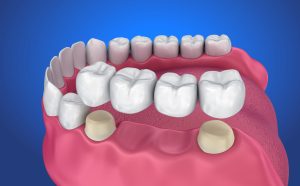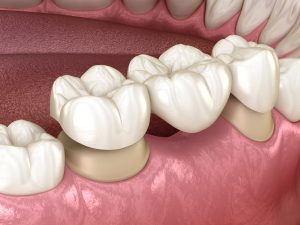One of the questions we get most frequently in our office is, what is a dental bridge? A dental bridge is a fixed, not removable, option to restore an area with a missing tooth. A dental bridge connects the teeth on either side of the missing tooth area. Like a bridge spans over water, the pontic tooth (middle tooth of the bridge) spans the missing tooth space.

A dental bridge can be a great option to restore a missing tooth area, but there are multiple factors to consider along the way. The first thing we will often look at is, would you be a good candidate for an implant instead of a bridge? If so, we will recommend this option 10 times out of 10. An implant is a very predictable way to restore a missing tooth area and we do not have to touch the adjacent teeth. Sometimes however, implants are just not an option, or may not be the best choice timing wise. Implants can take up to 6 months to put a crown on, whereas with a bridge, we can close the span in as little as 2 weeks. We can also get you in a temporary bridge the day you come in for treatment while we wait for the permanent bridge to be made at the lab. Bridges can be a great quick fix for emergency cases as well.
There are a multitude of scenarios where we can, if the adjacent teeth are healthy, close a large space of missing teeth. Typically, a bridge is “3 units” meaning it covers 3 teeth. But we have many cases where patients are missing more than one tooth, and we can still make a longer span bridge work for them. Most of these are very case dependent, but we have done many 4, 5, and even 6-unit bridges. The illustration below should help demonstrate this concept a little bit better!
 As you can tell, a bridge can be a great option to replace one or more missing teeth. A comprehensive dental exam will tell you whether or not you are a good candidate to get a bridge!
As you can tell, a bridge can be a great option to replace one or more missing teeth. A comprehensive dental exam will tell you whether or not you are a good candidate to get a bridge!
